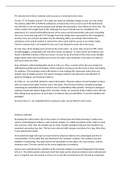P4: describe the forensic methods used to process a simulated crime scene.
On the 11th of October around 7:35 a body was found at Uxbridge College as soon as it was found
the witness called 999, at 8;00 the ambulance arrived at the crime scene to see if the body found
was still alive or not, the person passed away despite the paramedics' best efforts to revive him. The
victim couldn't be brought back to life. Although the cause of death was not established, the
appearance of a second unidentified person at the scene worried paramedics who were evaluating
the scene. Entry/exit logs and CCTV footage from that college were requested for the investigation,
but they have not yet been provided. The firs attending officer was already there before the
ambulance arrive and he started to restrict the crime scene and the access so no media, family,
friend or anyone that is not needed for the case is not allowed to enter the crime scene.
At 2:20, Zoya, Ifrah, Khadija and I arrived at the crime scene. As a first step, we put on PPE, which
included goggles, a disposable over suit with a hood, and gloves. To show where the evidence was
found, I sketched a picture of the occurrence. As soon as we all arrived at the crime scene, Khadija
began taking notes and recording every move we made, every particular, every piece of evidence,
and every action we took.
Zoya started to collect photographic proof at 2:26 p.m. Then, a search of the site was carried out
utilising the parallel search technique, which comprises moving across the scene in lines and looking
for evidence. This technique works effectively in crime settings like classrooms when there are
already rows of people present. The search strategy resulted in the discovery and collection of
physical, biological, and chemical evidence.
At 2:28 p.m., me and Ifrah started to collect information. Physical evidence found included a broken
stick, an empty wine bottle, lanyard, and a wine glass. The chemical evidence included a package
containing an unidentified brown material and an unidentified white powder. Among the biological
evidence found were blood, fingerprints, and hair. Finally, we removed all the evidence from the site
after taking close-up pictures of each piece of evidence that was identified. It was then labelled and
packaged.
Around 2:50 p.m., we completed all the necessary tasks, and we left the crime scene.
Evidence collected:
By placing the cotton swab's tip on the surface of a blood spot and slowly spinning it, swabs were
used to swab biological evidence, such as blood samples. To enable any blood on the cotton to soak,
this was done. After that, the sample was air dried. Another biological indicator that needed to be
examined and packed was hair. The hair was collected with tweezers and placed in a bag. After then,
it was marked and sealed.
Ifrah sealed the bags with tape to ensure that the physical evidence was undamaged and free of
contamination. On the label that was attached to the container evidence, the evidence was also
labelled in handwriting. The label had the full description of the object, the case number, and the
evidence room. This was carried out for every single piece of evidence.
Gloves were used during the collection of the chemical evidence to prevent fingerprints from being
left on it. The white powder and brown stuff that made up the chemical evidence were collected and
put in a bag that was also stored in a box so it can be after transferred to the lab and be examinate.
, All evidence was packed in different bags and labelled according to what evidence it was where it
was found and what time.
Evidence collected:
Overview of the scene
Sketch of the crime scene




